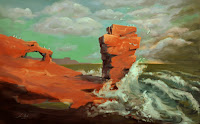"Abstract White" began with the same photo as the "Solar System Series". I wanted to create a counter piece to the dark images in the original abstract pieces. So I revisited them and turned out this new version. I started off by duplicating the layer and setting the layer to "Exclusion" which already changed the complete atmosphere and mood. Then I painted over parts to create some new structures and textures as well as create some more balance and remove others. I wanted to achieve a oil painting feeling in the end through different Photoshop brushes and filters.
Personal Interpretation
While creating this piece I imagined the bottom third to be a landscape. It resembles some grassy hills with bushes on them and the bright sun (light source) is overpowering the whole scene. The vegetation is very dried out due to the heat of the sun in this area. The vertical light beam from the sun leads directly down to the environment and underpins this idea.







































